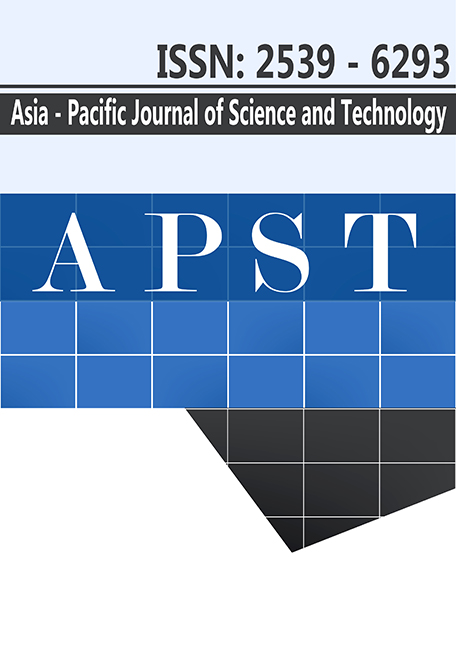An accident prevention model: Case study of a small-scale wood workshop in a developing country
Main Article Content
Abstract
Majority of processing activities in small-scale wood workshops are huge, including lifting, stacking and cutting
of wood materials. These generate substantial hazards, which trigger accidents, injuries and possibly death. To
prevent these calamities, a new accident prevention model is proposed based on barriers (human shields) that
safeguard the human body from attacks and damages. The effectiveness of creating and optimizing these barriers,using principal barriers for skin, organs (internal and external), bone and fatigue is presented. The predicted rate of accident occurrence ranged from 0 (best) to 0.4587 (worst) accident per period. The percentage rate of occurrence varied from 0 (best) to 26.85 (worst) accident percentages per period. The bone injury prevention barrier involving factors of trips, slips, contact with moving machine parts, and contacts with rollers yielded a range of values from 0.2635 to 0.4255. Results showed that a high percentage (almost 50%) of the probable accidents would be classified under external organ injury prevention barrier. Results further showed that EOIPB is a first degree accident. This implies that the wood workshop has a high degree of uncertainty in terms of predicting when and what type of accident is likely to occur. The main novelty of this contribution is the unique integration of barrier factors with the fault tree analysis and being able to optimise than using Lagrange’s multiplier. The presented methodology serves as an effective tool in the identification of influential accident causative factors, on a preventive basis, before any accident occurs. It can be appropriately applied in other processes, such as manufacturing with some practical utility to the safety coordinator.
Article Details
References
Senders, J., Moray, N., 1991. Human errors: their causes, prediction and reduction. Lawrence Erlbaum associates Incorporated, Hillsdale NJ.
Kjellen, U., 2000. Prevention of accidents through experience feedback. Taylor and Francis, London.
Andersson, R. Johansson, B., Linden, K., Svanstrom, K. and Svanstrom, L., 1978. Development of a model for research of occupational accidents, Journal of Occupational Accidents, Vol. 1, pp 341-352.
Svenson, G., 1991. The accident evolution and barrier (AEB) function model applied to incident analysis in the process industries, Risk Analysis, Vol 11, pp 499-507.
Lund, J., Aaro, L., 2003. Accident Prevention: Presentation of a model placing emphasis on human, structural and cultural factors, Safety Science, Vol. 42, No. 4, pp. 271–324.
Hollnagel, E., 2004. Barriers and Accident Prevention: Aldershot: Ashgate.
Aven T., Sklet S., Vinnem J.E., 2006. Barrier and operational risk analysis of hydrocarbon releases (BORA-Release); Part I Method description, Journal of Hazardous Materials, Vol. 137, pp. 681-691.
Carter, N., Menkel, E., 2003. Group routines for improving accident prevention activities and accident statistics, International Journal of Industrial Ergonomics, Vol. 5, pp 125-132.
Rathnayaka S, Khan F, Amyotte P. 2011a, SHIPP methodology: Predictive accident modeling approach. Part I: Methodology and model description, Process Safety and Environmental Protection, Vol.89, No. 3, pp. 151-164.
Rathnayaka S, Khan F, Amyotte P. 2011b, SHIPP methodology: Predictive accident modeling approach. Part II. Validation with case study, Process Safety and Environmental Protection, Vol.89, No. 2, pp. 75–88.
Gyekye S., 2003. Causal attributes of Ghanian industrial workers for accident occurrence: miners and non-miners perspective Journal of safety research. Vol 34, pp 533-538.
Owoh U.E. 2012.Application and verification of an accident prevention model.Unpublished B.Sc. Thesis, Department of Mechanical Engineering, University of Lagos, Nigeria.
Chi S. and Han S. 2013. Analyses of systems theory for construction accident prevention with specific reference to OSHA accident reports, International Journal of Project Management, Vol. 31, pp. 1027-1041.
Akynz, E., and Celik M. 2014. Utilisation of cognitive map in modeling human error in marine accident analysis and prevention, Safety Science, Vol. 70, pp. 19-28.
Fonsea E.D., Lima F.P.A., Duarte F. 2014. From construction site to design: The different accident prevention levels in the building industry, Safety Science, Vol. 70, pp. 406-416.
Joprgensen K. 2016. Prevention of simple accident at work with major consequences, Safety Science, Vol. 81, pp. 46-58.
Chinniah Y., 2015. Analysis and prevention of serious and fatal accidents related to moving parts of machinery, Safety Science, Vol. 75, pp. 163-173.
Bakish A., Khan F., Gadag V., Ferdous R. 2015. Network-based approach for predictive accident modeling, Safety Science, Vol. 80, pp. 274-287.
Van Nunen K., Reniers G., Ponnet K., Cozzani V., 2015. Major accident prevention decision-making: A large-scale survey-based analysis, Safety Science, in press.
Cowlagi R.V., Saleh J.H. 2015. Coordinability and consistency; Application of system theory to accident causation and prevention, Journal of Loss Prevention in the Process Industries, Vol. 33, pp. 200-212.
Kongsvik T., Almkhov P., Haavik T, Haugen S., Vinnmem J.E., Schiefloe P.M., 2015. Decisions and decision support for major accident prevention in the process industries, Journal of Loss Prevention in the Process Industries, Vol. 35, pp. 85-94.
Albrechtsen E., 2015. Major accident prevention and management of information systems security in technology-based work processes, Journal of Loss Prevention in the Process Industries, Vol. 36, pp. 84-91.
Monferini A., Konstandinidou M., Nivolianitou Z., Weber S., Kontogiannis T., Kafka P., Kay A.M., Leva M.C., Demichela M., 2013. A compound methodology to assess the impact of human and organizational factors impact on the risk level of hazardous industrial plants, Reliability Engineering & System Safety, Vol. 119, pp. 280-289.
Qureshi Z.H., 2008, A review of accident modelling approaches for complex critical sociotechnical systems, Command, Control, Communications and Intelligence Division DSTO Defence Science and Technology Organisation, Edinburgh South Australia 5111 Australia.
Kontogiannis T., Malakis S., 2012, Recursive modeling of loss of control in human and organizational processes: A systemic model for accident analysis, Accident Analysis & Prevention, Vol. 48, pp. 303-316.
Kontogiannis, T., Leopoulos V., Marmaras N., 2000. A comparison of accident analysis techniques for safety critical man machine systems, International Journal of Industrial Ergonomics, Vol. 25, pp. 327-347.
Pilot S., Back to Basics: What Is a Fault Tree Analysis? Accessed 27th April, 2016 at www. asq.org/quality-progress/2002/03/.../what-is-a-fault-tree-analysis.html


